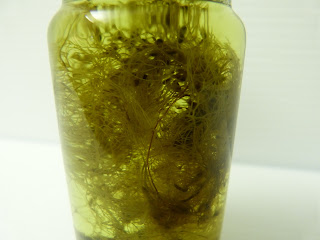Specimens Preserved in Jars
My work here requires a harmonious blend of both art and science. On some days, I might concentrate on the positioning of display signage, or the assortment of words printed on it each sign. Maintaining the aesthetics surrounding our collection helps to cultivate the public's interest, while accurate records and careful conservation help to keep the collection scientifically relevant. Last week my focus shifted heavily towards the science of curation--scrutinizing various jars filled with fluid and fetuses, unhatched eggs, and tiny aquatic insects. Often an overlooked component of the Museum's collection, fluid-preserved specimens actually number over 250 individual objects, and are a valuable resource for discovery.
 |
| Left to right: fetus of a raccoon, fetus of a white-tailed deer, and two northern brook lamprey. |
Immersing objects in a fluid solution isn't the oldest form of preservation, but it certainly has its roots in history. Ancient cultures regularly preserved foods in sealed containers with fluids such as vinegars or oil. Such a method protected organic materials against bacteria and prevented tissues from exposure to oxygen. Similar practices continue today. A long history of preservation techniques evolved over many centuries, and today both professional institutions and at-home preservation enthusiasts (they do exist) continue the art and science of fluid preservation.
Unfortunately, wet specimens are widely viewed as grotesque examples of nature's unusual or mutated--but that's largely perpetuated by films. As a matter of fact, the majority of specimens that benefit from fluid preservation most are organisms like macroinvertebrates and algae. Even minerals may be preserved in a jar. For a variety of specimens, a proper jar and the fluid solution inside are both paramount for their longevity--offering hundreds of years of preservation by creating a microenvironment of protection.
Unfortunately, wet specimens are widely viewed as grotesque examples of nature's unusual or mutated--but that's largely perpetuated by films. As a matter of fact, the majority of specimens that benefit from fluid preservation most are organisms like macroinvertebrates and algae. Even minerals may be preserved in a jar. For a variety of specimens, a proper jar and the fluid solution inside are both paramount for their longevity--offering hundreds of years of preservation by creating a microenvironment of protection.
Many of the fluid-preserved specimens in the collection are macroinvertebrates, ranging from the large eastern toe-biter to a small leech. They live in aquatic environments and likewise maintain well in them after death too. This similarly applies to aquatic plants. Why press and dry such an organism when its preserved structure could remain true to when it was first plucked out of its aquatic environment? I would certainly prefer to see the submerged parts of a bladderwort, full of hundreds of tiny "bladder" traps, drifting in liquid than flattened on a sheet.
 |
| Above, an eastern toe-biter (Benacus griseus). Below, a species of bladderwort (Utricularia sp.). |
While many of our fluid-preserved specimens are small, we do maintain some larger organisms. A new gift of fluid-preserved fetal mammals has helped to both diversify our collection and unsettle some docents. Despite being an unnerving sight, a mammal preserved in fluid presents a few advantages for scientific research projects. Both the anatomy and histology (the macro- and microscopic levels respectively) may be readily studied for many years into the future. Fluid preservation also allows for the entire organism to remain intact--where the internal tissues and intestinal contents would be removed in a taxidermy preparation, they may remain in a fluid preservation. It's incredible to realize what information may be found in organs of a deer, or in the crop of a grouse.
 |
| What might this be? Pictured here is the crop (at top) of a ruffed grouse, with numerous buds of an aspen that were found within it when dissected. |
Although no method of preservation can stop time indefinitely, we continue our efforts to postpone deterioration in the name of science. Whether dried, frozen, or submerged in alcohol, all of the objects in our collection give answers to our questions about the natural world when properly preserved.
